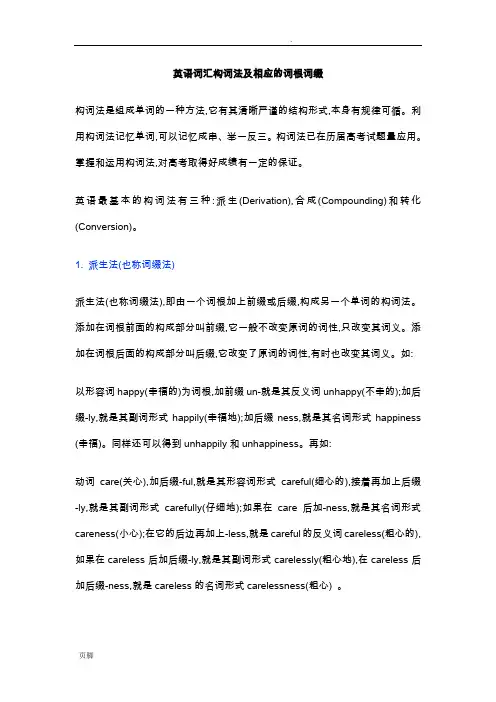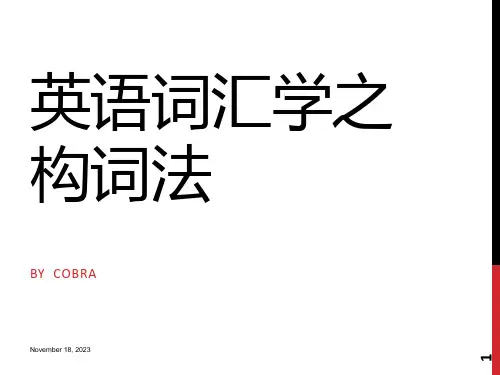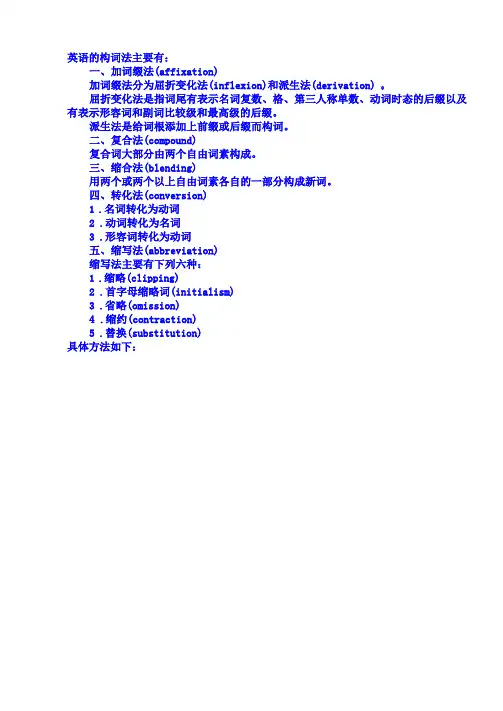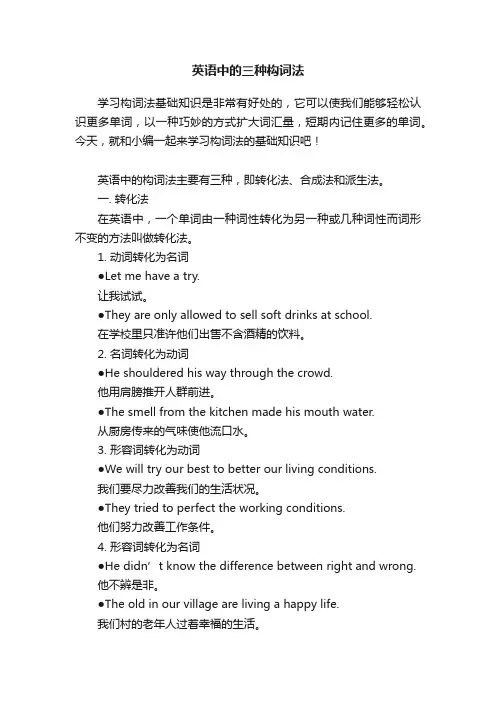现代英语词汇学概论--构词法
英语构词法(常用的词根词缀总结)

英语词汇构词法及相应的词根词缀构词法是组成单词的一种方法,它有其清晰严谨的结构形式,本身有规律可循。
利用构词法记忆单词,可以记忆成串、举一反三。
构词法已在历届高考试题量应用。
掌握和运用构词法,对高考取得好成绩有一定的保证。
英语最基本的构词法有三种:派生(Derivation),合成(Compounding)和转化(Conversion)。
1. 派生法(也称词缀法)派生法(也称词缀法),即由一个词根加上前缀或后缀,构成另一个单词的构词法。
添加在词根前面的构成部分叫前缀,它一般不改变原词的词性,只改变其词义。
添加在词根后面的构成部分叫后缀,它改变了原词的词性,有时也改变其词义。
如: 以形容词happy(幸福的)为词根,加前缀un-就是其反义词unhappy(不幸的);加后缀-ly,就是其副词形式happily(幸福地);加后缀ness,就是其名词形式happiness (幸福)。
同样还可以得到unhappily和unhappiness。
再如:动词care(关心),加后缀-ful,就是其形容词形式careful(细心的),接着再加上后缀-ly,就是其副词形式carefully(仔细地);如果在care后加-ness,就是其名词形式careness(小心);在它的后边再加上-less,就是careful的反义词careless(粗心的),如果在careless后加后缀-ly,就是其副词形式carelessly(粗心地),在careless后加后缀-ness,就是careless的名词形式carelessness(粗心) 。
前缀、后缀是构词的要素,具有一定的作用和意义。
懂得了前后缀的含义,就容易了解由前(后)缀和词根结合而成的单词的意义。
现把英语中我们常见的前后缀列举如下:1)前缀anti-反对: antisocial反社会的auto-自: automobile小汽车,autonomy自治bi-双: biannual 一年两次的, bicycle自行车by-在旁:bystander 旁观者, by-product副产品co- 同: co-operation合作,co-existence共处,co-worker同事counter-反:counter-attack反攻,counter-revolutionary反革命的dis-否定,除去: discover发现,disorder混乱,杂乱en-使成为: enable使能够,enslave奴役, encourage鼓励extra-外: extraordinary非常的,格外的for-,fore-,先,前,预: forward向前,foresee 预见,forearm前臂,foretaste先尝for-禁,弃: forbid禁止,forget忘记,forgo放弃in-,il-,im-,ir-不,非: informal非正式的,incomplete不完全的,indefinite不定的,illegal非法的,immoral不道德的,irregular不规则的inter-间,相互:internationalism国际主义,interview会见micro-微: microscope显微镜,microfilm微型胶片mid-中:midday 中午,midnight夜半,mid-autumn中秋的mis-误: misunderstand 误会,misuse误用,misfortune不幸non-非,不:non-moral非道德围的,nonsense胡言,nonexistent不存在的post-后于: postwar战后的pre-先于: prewar战前的re-重,再,复: rewrite重写, return返回, review复习super-上,超: superman超人,supermarket 超级商场tele-远: telephone,telescope望远镜,television电视un-不: unable不能的,unimportant不重要的,untrue不真实的vice-副:vice-chairman副主席,vice-premier副总理2)后缀-age状态,集合: marriage婚姻, shortage缺少,village 村庄-an人: American美国人,Italian意大利人,意大利籍,African 非洲人-ation,-ition动作,状态:determination决心,industrialization工业化,preparation 准备,competition竞争,repetition重复-dom状态,领界: freedom自由,kingdom王国-eer人: engineer工程师,volunteer志愿者-er人,动作者:fighter战士,worker工人,writer作家,thinker思想家,harvester收割机-ese人,语言:Chinese中国人,中文, Japanese日本人,日文-ess女性:actress女演员,princess公主,goddess女神-hood身分,境遇,状态: childhood 童年,womanhood女性-ian人: musician音乐家, guardian卫护者, Christian基督教徒-ism主义,教:communism共产主义,socialism社会主义,revisionism修正主义-ist主义者,人: communist共产主义者, artist 艺术家-ity (抽象名词): possibility 可能性, ability能力,equality平等-man人: Englishman英国人,英格兰人, postman邮递员-ment运动,结果: movement运动,development发展,judgement判断-ness状态,性质:kindness和善,carefulness小心,correctness正确,tiredness疲倦-or人,动作者: actor男演员,visitor访问者-ship状态,身份: friendship友谊,comradeship同志之友谊,sportsmanship 体育道德,hardship苦难-sion动作,状态: tension紧状态,revision修订-tion动作,状态: attention注意,action行动-less无:fearless 无所畏惧的,careless 不小心的,useless 无用的,meaningless 无意义的-ly品质,的: comradely 同志般的, friendly 友好的, weekly 每星期的-some引起,适于,易于: troublesome 烦人的,tiresome 令人感到厌倦的2. 合成法(也称复合法)把两个单词或两个以上的词合成一个新词,这种构词的方法叫做合成法。
英语词汇学之构词法PPT课件

-en
woolen, golden, wooden, earthen…
-ent different, dependent, existent, consistent…
-ic
realistic, poetic, historic, economic…
November 18, 2023
14
常见后缀2—形容词后缀
11
常见后缀1—名词后缀
后缀 例词
-an
Asian, American, Russian, African…
-ance attendance, performance, assistance…
-ation education, examination, pronunciation…
-dom
freedom, kingdom, wisdom, boredom…
spy(监视)
lower(更低的) lower(降低)
1818
其它构词法之截短法
缺点
杂乱 不喜欢
10
常见前缀3—特定意思
构成方式
anti-(反) auto-(自动) bi-(双) centi-(百分之一的) co-(共同) down(向下) ex-(以前的) fore-(前部的) full-(完全) November 18, 2023
例词
antiwar, anticancer, antipollution… automatic, autotimer, auto-record… bicycle, binoculars… centimeter, centigram, centigrade… co-operate, co-edit, co-exit… downstairs, downhill, downwards… ex-wife, ex-lover, ex-husband… forehead, foreleg, forearm… full-time, full-speed, full-strength…
词汇学之构词法课件

目录
CONTENTS
• 构词法简介 • 前缀构词法 • 后缀构词法 • 合成词构词法 • 转化词构词法 • 总结与展望
01 构词法简介
什么是构词法
01
构词法是研究词汇变化和形成的 科学,它主要研究词素组合的方 式、词素替换的规则等。
02
构词法包括词根、前缀、后缀、 词尾等元素,这些元素可以组合 、替换、变化,形成新的词汇。
构词法的重要性
构词法是语言学中重要的分支学科, 它对于理解语言的形成和发展、词汇 的变化规律以及语言的实际应用都有 重要的意义。
通过学习构词法,可以更好地理解词 汇的构成和意义,提高语言表达能力 。
构词法的分类
合成法
派生法
将两个或多个词素组合在一起形成新词的 方法。例如,“bookstore”由“book” 和“store”组合而成。
特点
前缀构词法是一种相对简单且易于掌 握的构词方法,通过添加前缀可以快 速创造新词。
规律
限制
虽然前缀构词法可以创造大量新词, 但并不是所有词根都可以随意添加前 缀,需要考虑到语言的语法和语义规 则。
前缀构词法有一定的规律可循,如 “dis-”通常表示否定意义,“re-” 通常表示重复或再次。
03 后缀构词法
04 合成词构词法
合成词的定义与构成方式
合成词定义
由两个或两个以上的词素组合而成的词。
构成方式
通过不同的组合方式,如名词+动词、形容词+名词、副词+动词等,形成具有特 定意义的合成词。
常见英语合成词举例
名词+动词
bookcase(书架)、 playground(操场)
形容词+名词
英语单词构词法

英语的构词法主要有:
一、加词缀法(affixation)
加词缀法分为屈折变化法(inflexion)和派生法(derivation) 0
屈折变化法是指词尾有表示名词复数、格、第三人称单数、动词时态的后缀以及有表示形容词和副词比较级和最高级的后缀。
派生法是给词根添加上前缀或后缀而构词。
二、复合法(compound)
复合词大部分由两个自由词素构成。
三、缩合法(blending)
用两个或两个以上自由词素各自的一部分构成新词。
四、转化法(conversion)
1.名词转化为动词
2.动词转化为名词
3.形容词转化为动词
五、缩写法(abbreviation)
缩写法主要有下列六种:
1.缩略(clipping)
2.首字母缩略词(initialism)
3.省略(omission)
4.缩约(contraction)
5.替换(substitution)
具体方法如下:。
英语构词法归纳和总结

英语构词法归纳和总结
英语构词法主要有以下几种:
1. 转化法:不添加任何词素,而把一个单词由一种词类转化为另一种词类。
例如:hand(n.手)—hand(v.传递),water(n.水)—water(v.浇水),等。
2. 派生法:在词根前面加前缀或在词根后面加后缀,从而构成一个与原单词意义相近或截然相反的新词。
例如:unable(不能),unhappy(不高兴),等。
3. 合成法:把两个或两个以上的单词结合在一起,构成一个新词。
例如:blackboard(黑板),classroom(教室),等。
4. 截短法:把一个较长的单词截取一部分,从而构成一个新词。
例如:photo(照片)—photo,zoo(动物园)—zoo等。
5. 首尾字母结合法:取单词的首尾字母,从而构成新词。
例如:bus(公共汽车)—ABS防抱死刹车系统,fan(扇子)—fanfare喇叭声等。
6. 混成法:把两个词各取一部分结合在一起构成一个新词。
例如:smoke and fog(烟雾),television (电视)等。
7. 音变构词法:通过发音的变化来构成新词。
例如:knife-knives,live-lives,man-men等。
以上就是英语构词法的归纳和总结,希望对你有所帮助。
英语中的三种构词法

英语中的三种构词法学习构词法基础知识是非常有好处的,它可以使我们能够轻松认识更多单词,以一种巧妙的方式扩大词汇量,短期内记住更多的单词。
今天,就和小编一起来学习构词法的基础知识吧!英语中的构词法主要有三种,即转化法、合成法和派生法。
一. 转化法在英语中,一个单词由一种词性转化为另一种或几种词性而词形不变的方法叫做转化法。
1. 动词转化为名词●Let me have a try.让我试试。
●They are only allowed to sell soft drinks at school.在学校里只准许他们出售不含酒精的饮料。
2. 名词转化为动词●He shouldered his way through the crowd.他用肩膀推开人群前进。
●The smell from the kitchen made his mouth water.从厨房传来的气味使他流口水。
3. 形容词转化为动词●We will try our best to better our living conditions.我们要尽力改善我们的生活状况。
●They tried to perfect the working conditions.他们努力改善工作条件。
4. 形容词转化为名词●He didn’t know the difference between right and wrong.他不辨是非。
●The old in our village are living a happy life.我们村的老年人过着幸福的生活。
5. 形容词转化为副词●How long have you lived there?你在那儿住多久了?6. 个别词在一定场合中可转化为名词●Warm clothes are a must in the mountains.穿暖和的衣服到山区去是必须的。
●Life is full of ups and downs.人生有得意时也有失意时。
英语词汇学之构词法
Example
"self confidence" is a compound objective formed from the words "self" and "confidence"
Example
"upload" is a compound verb formed from the words "up" and "load"
Other examples
"download", "email", "Google"
Verb synthesis
Objective synthesis
ቤተ መጻሕፍቲ ባይዱ
Transforming verbs into nouns
Verb to noun transformation: In English, it is also common for verbs to transform into nouns This process is called conversion or zero differentiation For example, the verb "to run" can be transformed into the noun "run," which can refer to a single act of running or a race Other examples include "to jump" (from "leap"), "to swim" (from "swim"), and "to write" (from "script")
英语构词法-(完整版)
英语构词法(完整版)一、词根、前缀与后缀英语构词法主要分为词根、前缀和后缀三种方式。
词根是单词的核心部分,通常包含了一个单词的基本意义。
前缀位于词根之前,用以改变单词的意义。
后缀位于词根之后,主要用来改变单词的词性。
1. 词根(1)act:表示“行动”,如:act(行动)、actor(演员)、action(动作);(2)bio:表示“生命”,如:biology(生物学)、biography (传记);(3)dict:表示“说”,如:dictate(口述)、dictionary (字典);(4)form:表示“形状”,如:form(形状)、formal(正式的)、format(格式)。
2. 前缀(1)un:表示“不”,如:unhappy(不快乐的)、unusual(不寻常的);(2)re:表示“再次”,如:rewrite(重写)、return(返回);(3)pre:表示“在……之前”,如:predict(预测)、preview(预览);(4)dis:表示“相反”,如:dislike(不喜欢)、disagree (不同意)。
3. 后缀(1)ness:表示“状态”,如:happiness(幸福)、sadness (悲伤);(2)ful:表示“充满”,如:hopeful(充满希望的)、careful(小心翼翼的);(3)ly:表示“副词”,如:quickly(迅速地)、slowly(慢慢地);(4)tion:表示“动作、状态”,如:action(动作)、invention(发明)。
二、合成法与派生法在英语构词法中,除了词根、前缀和后缀,还有合成法和派生法两种重要的构词方式。
这些方法丰富了英语词汇,使得表达更加精确和多样。
1. 合成法(1)名词+名词:如:snowfall(降雪)、bookstore(书店);(2)名词+形容词:如:worldwide(全世界的)、citywide(全市的);(3)形容词+形容词:如:darkblue(深蓝色的)、lightgreen (浅绿色的);(4)动词+副词:如:lookup(查阅)、takeover(接管)。
英语构词法详细讲解
构词法一、转化法(兼类词):指在不同的语境中,名词动用,动词名用等。
如:ok was the first to map (v.)the east coast.(库克是第一个画西部海岸地图的人)2.The house can house (v.)many people.(这房子可以住下好多人)二、合成词:英语中的合成词有合成形容词、合成名词、合成动词、合成副词、合成动词、合成代词等,如:合成形容词:well-known, warm-hearted, easy-going合成名词:raincoat, earthquake, waterfall,blackboard, classroom, motherland合成动词:underline, overcome,合成副词:maybe, wherever, however, therefore合成代词:himself, everyone, nobody三、派生法(词缀法或缀合法),这种词是最为活跃的一种,大约三分之二的英语单词是用这种方法构成的。
因此,掌握一些常用派生词的构词规律对于我们正确拼写单词和在阅读中猜词能力的培养就显得尤为重要。
在英语的派生词中,词根决定词的根本意义,前缀改变词义,后缀引起词类的的改变(个别后缀还会改变词义)1.名词后缀-er:writer, teacher, manager, worker, employer, interviewer-ee: employee, interviewee-or:actor, sailor, editor, beggar, operator-ian:librarian, American, physician-ist:scientist, physicist, artist, cyclist, typist, biologist, geologist-ese:Chinese, Japanese(-er, -ee,-or, -ian, -ist, -ese: 表示“从事某种职业或来自------的人” )-ism:Marxism, socialism, nationalism, communism (-ism表示----主义)-ess:actress, waitress, hostess (-ess表示性别)-ness:happiness, illness, coldness, carelessness, sickness-ment:movement, agreement, achievement, appointment, adjustment-ship:friendship, hardship(困苦、苦难、艰难困苦)-ion:education, decision, communication, impression, description, collection-ity:reality, purity, responsibility, possibility-ance(ence):performance, independence, science , violence, reference, appearance-ure:failure, departure(分离,分开)-al:arrival,survival, signal-hood:childhood, boyhood, neighborhood, livelihood-th: truth, depth,(-ism, -ess, -ness, -ment, -ship, -ion, -ity, -ance(ence), -ure, -al, -hood, -th: 表示“行为的过程、状态或性质”)2.形容词后缀-less: hopeless, endless, careless, helpless, (表“否定”)-ful: useful, careful, hopeful, grateful, powerful-ous:dangerous, humorous, cautious, infectious-able:enjoyable, comfortable, considerable, admirable, unforgettable-y:snowy, dirty, greedy, rainy, sunny, guilty-ent(-ant):different, independent, confident, violent, efficient, distant-tic: optimistic, pessimistic, enthusiastic, characteristic-ary: necessary, revolutionary, imaginary-(c)al: historical, unusual, professional, magical, physical, universal, classical, logical, informal-some:handsome,troublesome-en:woolen, golden,-an:African, American-ive:active, attractive, creative(-ful, -ous, -able, -y, -ent, -some, -en, -an, -ive :表示“属性、倾向、相像”)3.副词后缀-ly:really, nearly, differently, finally, fluently, gradually-wise: (表示“方向、样子、状态、在------方面”)likewise, otherwise-ward(s): upward, downward, inward, outward, backward, forward, afterwards4.动词后缀-ize(-ise): organize, apologize, specialize-en:harden, fasten(使固定、使牢固), soften-fy: beautify, simplify, classify-ate: separate, operate(-ize(-ise), -en, -fy, -ate: 表示“使成为、处理、作用”)5.反义词前缀un-: unfair, unknown, unlike, unwilling, unfit, unnecessary, unlikely, unkinddis-: dislike, disappear, disadvantageim-: impossible, immoral, impatient, impractical, improperin-: incorrect, inappropriate, informalnon-: nonsmoker, nonsense,non -drinker(un-, dis-, im-, in-, non-: 表示“无、不、非”)mis-: mistake, mislead, misunderstandmal-:malfunction(发生故障;不起作用)(mis-, mal: 表示“反动作”)6.其他表示空间、位置、方向、关系、程度的前缀(1) a- , up-, over-, sur-, super- : 表示“在------之上”aboard, uphill, overlook, surface, supermarket, superstar(2)extra-, ex-, out- :表示“在-----之外”:extraordinary, export, outside, outdoors(3)under-, sub-, vice- :表示“在----之下”:underground, subway, vice-president(4)inter-: 表示“两者间”:internet, international, interpersonal(5)co-, con-, col-, com-: 表示“相同、相等合作”coexist(共存,和平共处), connect, collect, combine(6)trans-:表示“移动” translate, transform, transmit(传输信号等),transfer(转让、转移)(7)anti-反,抗,阻:anti-black, antibody, anti-depressant(抗抑郁的)(8)re-再,又:rebuild, rewrite, retell(9)micro-microbiology, microcomputer, microscope, microwave(微波)(10)tele-:远距离的,远的:telephone, television, telescope, teleprinter(电传打印机)四、缩略词缩略:为了称说方便,使事物称谓中的成分进行有规律的节缩或者省略叫做缩略。
(完整版)英语基本构词法
英语基本构词法英语最基本的构词法(word formation)有三种:派生(derivation)、合成(compounding)和转化(conversion)。
利用构词法记忆单词,可以记忆成串,举一反三。
Ⅰ。
派生法派生词缀和词根结合,或者粘着词根和粘着词根结合构成单词的方法,叫做派生法(derivation),也称作缀词法。
用派生法构成的词叫做派生词(derivative).派生词的词缀法是英语构词法中最活跃的一种,在英语构词的历史上发挥极其重要的作用。
另外,这种构词法也是我们可以发挥能动性借以扩大词汇量的一种构词法。
词缀分为前缀和后缀两种。
A.前缀1.表示“否定”、“相反”意义的前缀:de— decrease减少;decentralize分散;degrade降级,降低……的地位;dis- dislike不喜欢;disagree不同意;distrust不信任;disappear消失;il— illegal不合法的;illogical不合逻辑的;illegalize宣布……为非法;im— impossible不可能的;immoral不道德的;impractical不现实的;un- unwilling 不情愿的; unbelievable 难以置信的;unnecessary 不必要的等等。
2.表示时间先后的前缀ex— ex-husband前夫;ex-president前总统;fore- foretell语言;foresight先见之明,预见;foresee预见,预知;mid— midterm其中的;midnight午夜;post— postwar战后的;postgraduate研究生;postdoctoral博士后的等等。
3.表示方向位置的前缀ex- export出口;exclude把……排斥在外;external外部的;in— input输入;indoor室内的;inrush涌入;incoming进来的等等.4.表示程度的前缀extra- extraordinary非凡的,惊人的;extracurricular课程以外的;out— outnumber比……多;outrun超过,跑得比……快;sur- surpass超过,优于;surplus剩余的;surrealism超现实主义等等.5.表示数量的前缀bi- bilateral双边的,两边的;bipartisan两党的;bilingual两语的;mono— momocycle独轮车;monologue独白;monodrama独角戏,单人剧;poly- polyacid多酸的;polyclinic多科联合诊所;polycentric多中心的等等。
- 1、下载文档前请自行甄别文档内容的完整性,平台不提供额外的编辑、内容补充、找答案等附加服务。
- 2、"仅部分预览"的文档,不可在线预览部分如存在完整性等问题,可反馈申请退款(可完整预览的文档不适用该条件!)。
- 3、如文档侵犯您的权益,请联系客服反馈,我们会尽快为您处理(人工客服工作时间:9:00-18:30)。
Root/ 词根: is not further analyzable, either in terms of derivational or inflectional morphology Stem/ 词干: the part of the word-form which remains when all inflectional affixes have been removed. Base/ 词基: any form to which affixes of any kind can be added.
答案:C
风蚀岩石 weather-beaten rocks 日晒的健康肤色 suntanned (skin) 吹毛求疵的人 a fault-finding person 破纪录的速度 a record-breaking speed 免税的 tax-free 无忧无虑的 care-free 防火的 fire-proof 隔音的 sound-proof 滴水不漏的 water-tight 密封的,不漏气的 air-tight
2. Phonological criterion: Compound accent: a main stress on the first element and secondary stress on the second element. Normal phrase accent: a secondary stress on the first element and the main stress on the second element.
A combining form[构词成分]: a bound morpheme, which was originally a full word in Latin or Greek, but which now occurs only in derivatives. e.g. autobiography hydromechanics television autobiography auto- = autos (Gk) = self self + life + write autoalarm autocracy (auto + alarm) (auto + cracy) (self + to + weapon) (self + ruling ) hydromechanics hydro- = hydòr (Gk) = water hydro-airplane hydrography dehydrate hydrogen television tele- = tele (Gk) = far off telecontrol telephone
2) denationalized denationalized = de + nation + al + ize + d Root: nation Stem: denationalize Base: national → nation nationalize → national denationalize → nationalize denationalized → denationalize
desirable: desire (root or base, not stem) undesirable: desirable (base, not root, not stem) undesirables: undesirable (stem or base, not root) desired: desire (root, stem or base)
undesirables = un + desire + able + s
Base:
desirable → desire (base) undesirable → desirable (base) undesirables → undesirable (base)
Base/词基: any form to which affixes of any kind can be added.
没膝深的 knee-deep 齐肩高的 shoulder-high 终身的 lifelong 晶莹剔透的 Crycle-clear 苦乐参半的 bittersweet 谈论的话题 talked-about topic 杜撰的故事 made-up story 24小时看守 round-the-clock watch 作现场勘查 make an on the sop inspection
E.g.
E.g. flowerpot workday backyard
Note: we can infer the meaning from the meaning of its component parts
red tape (官样文章,烦琐拖沓的公事程 序) dog days (the hottest day of the year) flatfoot (a policeman) blue blood (the quality of being a nobleman by birth) blue ribbon (an honor given to the winner of the first prize) Note: we cannot infer the meaning from the meaning of its component parts back
The relative criteria of a compound
1. Orthographic criterion: Compounds are written in three ways, that is, solid, hyphenated and open. E.g. flowerpot Solid: flowerpot Hyphenated: flower-pot Open: flower pot
Chapter 3(构词法)
3.1 General Remark 概述 3.2 Compounding 复合构词法 3.3 Derivation 派生构词法 3.3.1 Prefixation 加前缀 3.3.2 Suffixation 加后缀 3.4 Conversion 词类转换法
The differences between “root”, “stem” and “base”?
E.g. black list blackboard blue bottle
3. Semantic criterion: Semantically, compounds can be said to have a meaning which may be related to but cannot always be inferred from the meaning of its component parts.
thunder-struck (houses) houses are struck by thunder / thunder struck the houses well-behaved (person) The person behave himself well. peace loving people people love peace an ocean-going (ship) A ship go across ocean.
The classification of compounding?
Compounds are classified b. Syntactic relation subject and verb 主谓关系 according to parts of verb and object 动宾关系 speech of the verb and adverbial 谓状关 compounds and 系 subdivided by the syntactic relation of the restrictive relation 限制关 系 compounding element. coordinating relationship a. Parts of speech 并列关系 1. n. compounds …… 2. adj. compounds 3. v. compounds
3.3 Derivation 派生构词法
Questions: 1. What is derivation? 2. What is combining form? And what difference between a combining form and an affix? 3. The classification of derivation.
3.2 Compounding 复合构词法
Questions: 1. What is compounding? 2. What are the relative criteria of a compound? 3. The classification of compounding?
What is compounding?
Combining forms are distinguished from affixes by their ability to occur as one constituent of a word whose only other constituent is an affix. e.g. autocracy hydrography telephone autocracy = auto [构词成分] + cracy (suffix) hydrography = hydro [构词成分] + graphy (suffix) telephone = tele [构词成分] + phone (suffix) From the point of view of derivation, no distinction should be made between combining forms and affixes in this book, in which all the combining forms are labeled either as prefixes or suffixes.
